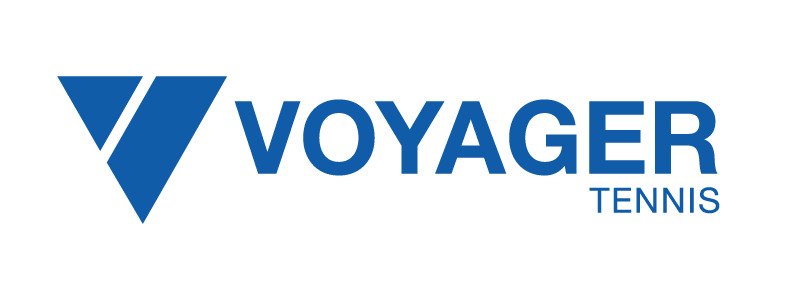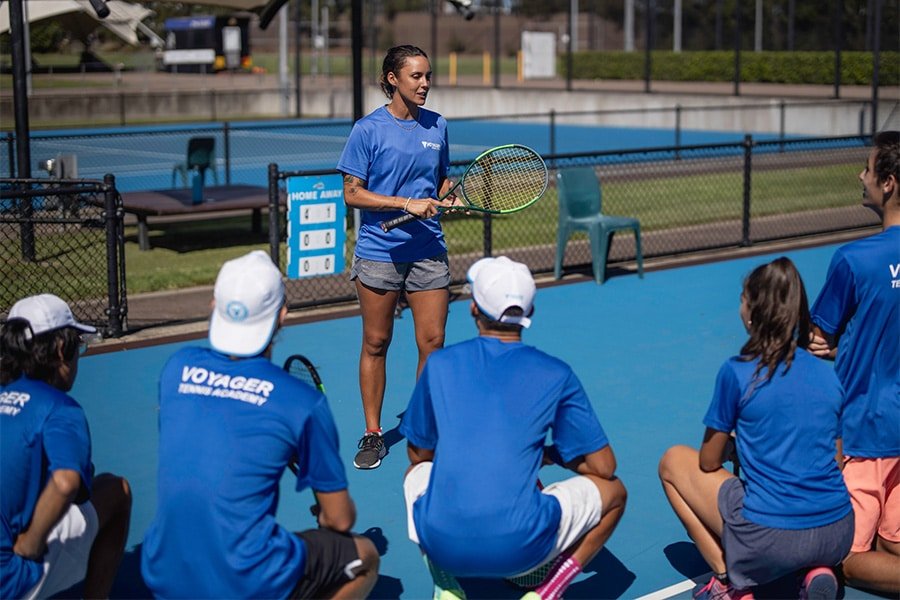
This article outlines how taking a purposely goal-oriented approach to a players development can be hugely beneficial. It also explains how you can use the UTR system as a tool to evaluate progress and benchmark where a player is at compared with their peers and whether they are on track to achieve their desired goals for their tennis career. US colleges need clear benchmarks of a player’s UTR and academic performance for acceptance.
Goal getting
To achieve your desired tennis ambitions, it is critical to set goals from which you can make a plan. Developing a tennis game that enables you to compete and win against other players at the desired level is a long-term project that requires continual improvement, so identifying key areas and then setting specific targets is a powerful technique.
The power of goal setting is described in the compelling book What They Don’t Teach You at Harvard Business School by Mark McCormack (who founded International Management Group Sport). In his book, Mark describes a study conducted in the Harvard 1979 MBA programme. The students were asked the question, ‘Have you set clear written goals for your future and made plans to accomplish them?’
- 3% of the students had written goals with plans to achieve them
- 13% had some idea of goals, but they weren’t written down
- 84% had no specific goals
Ten years later, the graduates were interviewed again. The results were incredible:
- The 13% who had goals were earning on average twice as much as the 84% who had no goals
- The 3% who had clearly defined written goals were earning an average of ten times more than all of their other classmates combined
Goal setting and measuring progress increases motivation and sharpens focus, and it is something many of the world’s best players do regularly.
Measuring the outcome
Measuring progress is critical to top players to see whether they are on or off track to achieve their goals. When they are competing professionally, the professional ranking systems is a good reflection of their level.
Within junior tennis, before the Universal Tennis Rating (UTR) existed, the only way to measure progress was by looking at birth year rankings in their country. These rankings are useful from the point of view of measuring your child’s birth year ranking against competitor players, but they are blunt tools as they can be inflated by players doing well in tournaments with weak fields. As a result, you can’t fully rely on junior rankings as an accurate tool for measuring progress particularly compared to players internationally.
The ultimate tennis measuring tool
Junior and senior players can now measure their level against players from all over the world through the UTR. The UTR is much like the handicap system in golf and works out a player’s rating based on their last thirty match performances, taking into account the number of games they’ve won/lost.
The UTR allows players to measure themselves against players at any level of the game, including the pros. As an example, a fourteen-year-old player who has just won nationals in their country may be interested in how good they are compared to the best players in the world for their age. They can find out by looking at who won the 14/U World Championships or the 14/U European Championships (where many of the world’s best juniors compete). They can then search that player’s UTR and compare it to their own.
Players can now use their UTR as a focus for their development. As a player improves under match conditions, so will their UTR which is why it’s a fantastic tool for tracking progress.
Voyager player tracking model
To produce the player model, we used a combination of the UTR, National, International Tennis Federation (ITF), ATP and WTA rankings systems and US college data so that you can see what level a player is currently tracking for at each age group. There are a few things to keep in mind when you’re viewing the model:
- Every player will develop physically and mentally at different ages. From our experience, players who have a late growth spurt will experience a climb in their UTR in line with this.
- Players who are looking to go to college but are young for the year at school will need to prioritise their year before their age when looking at the tracking graph. This is because players will be accepted into a college within a couple of months of completing Year 12.
- If a player is not tracking where they’d like, don’t worry. Our future articles will provide an analysis of the right quantity of training and matches to achieve the various levels of tennis.
The levels in the graph represent the opportunities that will be available and most suitable for a player if they are tracking in that area.
Level 1 | ||
National position | These players are typically among the best few players in their country for their age group. | |
US college opportunities | Tennis scholarships into most prestigious US college teams + Ivy League opportunities. | |
Playing opportunities |
- National ranking tournaments (usually winning or making finals for their age group) - Junior World Championships (Orange Bowl/Tarbes) -ITF Junior World Circuit (if prepared to sacrifice education and travel extensively)
- Area representation (country representation)
- European club tennis (potential to be paid well for every match) - Professional ATP/WTA tour (top 100 in the world possible) - Seniors tour (likely highly world ranked for age groups) | |
Level 2 | ||
National position | These players are typically good nationally ranked players who are around the fringe of gaining acceptance into closed national title junior events in their respective countries. | |
US college opportunities | Tennis scholarships into good Division 1 colleges. | |
Playing opportunities |
- Local inter-club tennis (competing against other teams in area) - Inter-school tennis competitions -National ranking tournaments
Area representation (local or state representation)
- European club tennis (payment likely to represent a team) - Professional ATP/WTA tour (lower and mid-level professional possible) - Seniors’ tour | |
Level 3 | |||
National position | These players are typically among the best few players in their country for their age group. | ||
US college opportunities | Tennis scholarships into Division 2, junior colleges and below | ||
Playing opportunities | Some common and suitable opportunities for these players are:
- Local inter-club tennis (competing against other teams in area)
- Area representation (local or regional)
- Seniors’ tour (will compete well in local senior tour events) | ||
Male tennis players’ UTR tracking graph | |||
Age/Year at school | Level 1 | Level 2 | Level 3 |
Age 8/Year 2 | 3+ | N/A | N/A |
Age 9/Year 3 | 5+ | 3+ | N/A+ |
Age 10/Year 4 | 6.25 | 4+ | 3.25+ |
Age 11/Year 5 | 7.5+ | 5.25+ | 4.25+ |
Age 12/Year 6 | 8.5+ | 6.25+ | 5.5+ |
Age 13/Year 7 | 9.5+ | 7.25+ | 6.+ |
Age 14/Year 8 | 10.25+ | 8.25+ | 7+ |
Age 15/Year 9 | 11.25+ | 9.25+ | 7.75+ |
Age 16/Year 10 | 12+ | 10+ | 8.5+ |
Age 17/Year 11 | 12.75+ | 10.75+ | 9+ |
Age 18/Year 12 | 13.5+ | 11.5+ | 9.5+ |
Female tennis players’ UTR tracking | |||
Age/Year at school | Level 1 | Level 2 | Level 3 |
Age 8/Year 2 | x | x | x |
Age 9/Year 3 | 2.25 | x | x |
Age 10/Year 4 | 4.25 | 2.5+ | 1.5+ |
Age 11/Year 5 | 5.75+ | 3.5+ | 2+ |
Age 12/Year 6 | 6.5+ | 4.75+ | 3+ |
Age 13/Year 7 | 7.5+ | 5.75 | 4+ |
Age 14/Year 8 | 8.75+ | 6.5+ | 4.5+ |
Age 15/Year 9 | 9.25+ | 7+ | 5+ |
Age 16/Year 10 | 9.75+ | 7.5+ | 5.5+ |
Age 17/Year 11 | 10.25+ | 8+ | 6+ |
Age 18/Year 12 | 10.5+ | 8.5+ | 6.5+ |
As an example, if John is in Year 9, turns fifteen this year and has a UTR of 9, he is on track to have a UTR of above 9.25 by the end of the year and to target a Division 1 college by the end of Year 12. If Bobby, who is thirteen, has the goal of a Division 1 college and has a UTR of 6, then he is way off the target of 7.25 and needs to look to adjust his training volume and match play quantity accordingly to accelerate his UTR.
We have undertaken over 100 case studies, and some important notes and observations we have made are:
- The most common reason for a player not tracking where they’d like to be is lack of training and match play.
- Players can catch up by implementing an appropriate training and competition plan that aligns with the level of play they desire to compete at (discussed in detail in an upcoming article).
- With the right training and competition plan, players can jump up two to three UTR levels in a twelve-month period. We have seen several examples of this happening.
If you don’t know what your UTR is, visit www.myutr.com and sign up to the premium version to get two decimal places in the rating.
Academic benchmarks
These are the approximate academic benchmarks required for US colleges.
College type | Required grades from Year 10 onward | SAT score |
Ivy League and a selection of programmes from NCAA Division 1, 2 and 3 | A’s only | 1,350+ |
NCAA Division 1 | Bs and Cs | 1,000+ |
NCAA Division 2 | Bs and Cs | 1,000+ |
NCAA Division 3 | Bs and Cs | Subject to each university |
NAIA | Bs and Cs | 900+ |
Junior college | A completed high-school certificate | No specific requirements |
A few points to note:
- There are exceptions to these benchmarks
- These are guidelines only and will vary in each country
- These benchmarks could change from time to time
- Subject selection is also critical for entry into US colleges
We would encourage you to seek expert advice before making big academic decisions.
For those looking to go to a university outside of the United States, there will be minimum academic requirements to reach as well. The most important aspect about setting academic goals is to know what needs to be achieved and measure progress along the way.
Developing goals and an action plan
Below is a template that players can use to set their main tennis and academic goals. We use the tennis and academic benchmarking tools to provide players with a reference point; with regard to training hours and match play quantity, please use the graphs in the following articles for guidance.
The template is self-explanatory, but it’s often a useful exercise to have a session with an expert to develop the action plan.
Ambitions | |
Long-term goal as a player: | |
Long-term career goal after tennis: | |
Current school grade average: | School grade average goal: |
Current UTR: | My current UTR is tracking for which level: |
End of year UTR goal: | Year 12 graduation UTR goal: |
Taking action | |
Below is a list of actions that I will be taking in order to achieve my goals | |
What will I need to do to achieve my school grade goals? | |
Number of hours I need to practise per week to achieve my tennis goals: | Number of matches I need to play in the next twelve months to achieve my goals: |
Technical: | |
Tactical: | |
Psychological: | |
Physical: | |
Nutrition: | |
Download the template here.
Summary
Setting goals and measuring progress is an essential part of the elite player’s journey. High performers across all industries are goal oriented and continually assess how they are progressing, and the UTR is a key tool for setting tennis goals.
Actions to consider:
- Think about the outcomes you want to achieve. What level are you aspiring to?
- Benchmark the UTR that you need to achieve for that level
- Understand the academic requirements of colleges
The next two articles will help you to create a specific action plan that aligns with the goals have set.
By Ryan Henry, Managing Director of Voyager Tennis and Ex-Pro Tennis Player




